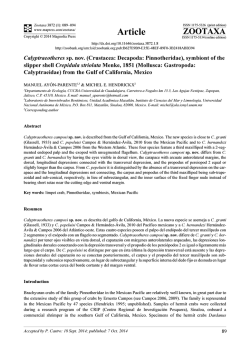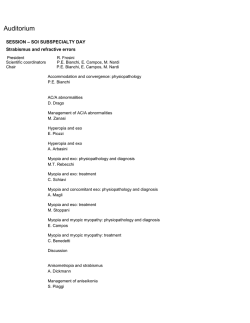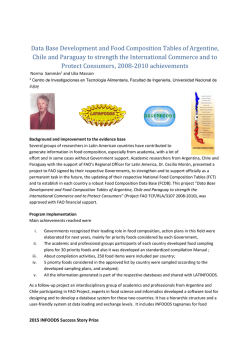
IS AVAILABILITY OF TROPHIC RESOURCES RELATED TO
Mastozoología Neotropical, 22(2):279-287, Mendoza, 2015 Copyright ©SAREM, 2015 Versión impresa ISSN 0327-9383 Versión on-line ISSN 1666-0536 http://www.sarem.org.ar Artículo IS AVAILABILITY OF TROPHIC RESOURCES RELATED TO CREVICES SELECTED BY Octomys mimax IN THE MONTE DESERT? Valeria E. Campos1,2, Stella Giannoni1,2,3, Laura Reus3, Gabriela Díaz4, and Claudia Campos1,5 Interacciones Biológicas del Desierto (INTERBIODES). Universidad Nacional de San Juan- CUIM, Av. I. de la Roza 590 (O), J5402DCS Rivadavia, San Juan, Argentina. [Correspondence: Valeria Campos <[email protected]>] 2 CIGEOBIO, UNSJ CONICET, Universidad Nacional de San Juan- CUIM, Av. I. de la Roza 590 (O), J5402DCS Rivadavia, San Juan, Argentina. 3 Departamento de Biología, Facultad Ciencias Exactas, Físicas y Naturales. Universidad Nacional de San Juan- CUIM, Av. I. de la Roza 590 (O), J5402DCS Rivadavia, San Juan, Argentina. 4 Facultad de Ciencias Exactas y Naturales. Universidad Nacional de Cuyo. Campus Educativo Municipal II. Rosario Vera Peñaloza esq. Fray L. Beltrán Malagüe, M5613CSE Malargüe, Mendoza. 5 Instituto Argentino de Investigaciones de Zonas Áridas (IADIZA – CONICET), CC 507, 5500 Mendoza, Argentina. 1 ABSTRACT. Rocky habitats have a particular microclimate and a highly complex structure, providing sites that mammals can use as dens or as nesting sites to raise their young. The complex topography of these habitats also favors water retention, thereby promoting growth of plants. The viscacha rat (Octomys mimax; Rodentia, Octodontidae) is a rock-dwelling hystricognath rodent that lives in rocky crevices with high vegetation cover. We hypothesized that viscacha rat selects crevices with high availability of plants included in the diet. To test this, we analyzed the diet of the viscacha rat and compared the availability of consumed plant species between used and available crevices. The diet of this species is composed mainly of leaves of shrubs and trees, includes cacti throughout the year and seeds and fruits, principally Prosopis spp., in the wet season. The food items present in caches confirmed the results obtained from microhistological analysis, with the addition of Ramorinoa girolae and Halophytum ameghinoi. This rodent takes advantage of consuming and storing available items, behaving as an opportunistic species. Selected plant species were similar in abundance in used and available crevices; consequently, crevices are likely selected for other characteristics such as thermal benefits, an important constraint in desert environments. RESUMEN. ¿La disponibilidad del recurso trófico afecta la selección de grietas por Octomys mimax en el Desierto del Monte? Los ambientes rocosos se caracterizan por un microclima particular y una compleja estructura que es usada por los mamíferos como sitios de anidación o como guaridas para sus crías. La topografía de estos hábitats favorece la retención de agua, promoviendo así el crecimiento de las plantas. La rata vizcacha (Octomys mimax; Rodentia, Octodontidae) es un roedor histricognato rupícola que vive en grietas rocosas con alta cobertura vegetal. Nosotros planteamos la hipótesis de que la rata vizcacha selecciona grietas con abundante disponibilidad de las plantas que consume. Para ello, analizamos la dieta de la rata vizcacha y comparamos la disponibilidad de las especies de plantas que consume este roedor, entre grietas usadas y disponibles. Nuestros resultados mostraron que la dieta está compuesta principalmente por hojas de arbustos y árboles, incluyendo cactus a lo largo del año y semillas y frutos, principalmente Prosopis spp., en la temporada de lluvias. Las especies registradas en los cúmulos de las grietas confirmaron los resultados obtenidos a partir del análisis microhistológico y agregan a Ramorinoa girolae y Halopthytum ameghinoi. Este roedor consume y Recibido 27 octubre 2014. Aceptado 26 junio 2015. Editor asociado: M Kittlein 280 Mastozoología Neotropical, 22(2):279-287, Mendoza, 2015 http://www.sarem.org.ar VE Campos et al. almacena ítems disponibles, por lo que se comporta como una especie oportunista. La abundancia de las especies seleccionadas por la rata vizcacha fue similar en las grietas usadas y disponibles; probablemente la selección de las grietas responda a otros factores como el beneficio térmico, una limitación importante en el desierto. Key words: Desert environment. Diet. Habitat selection. Rock-dwelling mammal. Viscacha rat. Palabras clave: Desierto. Dieta. Mamífero rupícola. Rata vizcacha. Selección de hábitat. INTRODUCTION Rocky habitats are ubiquitous around the world, occurring both in extremely hot, dry deserts and in very cold alpine regions; they may range continuously without interruption across the landscape, e.g. continuous mountain ranges, or occur in clumped isolates (Nutt, 2007). These habitats have a highly complex structure and a particular microclimate, offering sites for shelter, which mammals may use as nesting sites or as dens to raise their young in a stable environment, relatively secure from predators (Mares, 1997; Nutt, 2007). Several non-mutually exclusive hypotheses have been proposed to explain why many rodents live in rocky habitats (see review in Nutt, 2007). One of them postulates that the topography of rocky habitats allows for small water accumulations during periods of rain, which increases the humidity of the area around rocks. This increased availability of water creates points where richness of plant species is high and plants remain green for long periods, thereby improving food availability (Mares, 1997; Fredericksen et al., 2003; Nutt, 2007). The viscacha rat (Octomys mimax Thomas 1920, Rodentia, Octodontidae) is a rock-dwelling hystricognath rodent that selects crevices in rocky outcrops as resting and nesting places with high vegetation cover (Ebensperger et al., 2008; Traba et al., 2010; Campos, 2012; Campos and Giannoni, 2013). The viscacha rat is endemic to western Argentina and occurs in the Monte ecoregion and in a transition area between the Monte and Chaco Seco ecoregions. The population at Ischigualasto Provincial Park, the one occurring in the most arid portion of the Monte, has received the greatest attention so far (see review in Sobrero et al., 2010). The viscacha rat is considered one of the most desert-adapted species, based on ecomorphological characteristics (Mares, 1975). Anecdotal observations of food caches in crevices led to think for a long time that the viscacha rat’s diet was based on cacti (Mares, 1975; Ojeda et al., 1999). Following the hypothesis that rock-dwelling rodents select crevices with abundant food, we expect that used crevices will have a higher abundance of plant species consumed by the viscacha rat than available crevices. Our objectives were: 1) to analyze seasonal composition of the viscacha rat’s diet, and 2) to compare the availability of consumed plant species between used and available crevices. METHODS Study area The study was conducted at Ischigualasto Provincial Park (IPP), San Juan province, Argentina (29º 55´ S, 68º 05´ W; Fig. 1). This protected area is located in a hyper-arid sector of the Monte biome, which corresponds to the northern Monte of hills and closed basins (Monte de Sierras y Bolsones, Burkart et al., 1999). Average annual precipitation is 100 mm (Labraga and Villalba, 2009). Temperature is characterized by considerable day/night variations (Abraham and Martínez, 2000) and a wide temperature range throughout the year; mean annual temperature is 22 ºC, with a maximum of 45 ºC and a minimum of -10 °C (Márquez, 1999; Cortez et al., 2005). This area is dominated by rocky outcrops of sandstones with varying salt content, with areas of fine-textured substrates (sands and clays) where water accumulates after rainfall (Márquez et al., 2005). Vegetation is xerophytic due to low rainfall and high temperatures (Márquez, 1999). It is characterized by open scrublands dominated by shrubs (Larrea cuneifolia, Zuccagnia punctata, 281 DIET AND CREVICE SELECTION BY Octomys mimax Fig. 1. Map of Ischigualasto Provincial Park (dashed line). Prosopis torquata), cacti (Echinopsis terschesckii), and bromeliads, such as Deuterocohnia longipetala, and Tillandsia sp. (Márquez et al., 2005; Acebes et al., 2010). Vegetation cover is very heterogeneous, ranging from 5 to 80% (Márquez et al., 2005), due to the vegetation being shaped by edaphic factors and distance from watercourses (Acebes et al., 2010). Botanical composition of the seasonal diet In order to estimate the use of food resources, samples of fresh feces were collected during the dry (April-October 2005; N=25) and wet (November 2005-March 2006; N=15) seasons, from crevices located at least 100 m apart. Fresh feces are readily recognizable by color and glossiness (Traba et al., 2010; Campos, 2012). Diet composition was analyzed by microhistological analysis of feces following the method described in Dacar and Giannoni (2001). The microhistological analysis of feces yielded similar results compared to other methods for studying diet composition, and it is the least invasive and most practical technique for evaluating dietary composition in field conditions (Mohammad et al., 1995). For preparing fecal samples for analysis, we used a macerating solution of 17.5 % NaHCO 3 (sodium bicarbonate) for about 24 h. The material was rinsed with tap water and sieved through a metal screen with openings of 74 μm. Three microscope slides were prepared from each sample. Fifty microscope fields were systematically examined on each slide under a microscope at × 400 magnification, totaling 150 fields per sample. Histological features of leaf epidermis, seed coats and fruits were used to identify food items on the slides by comparison with a reference collection (microhistological slides of plant material of known species). Only one identifiable fragment, the largest one present, was considered per microscope field. We recorded the presence of a food item and determined its relative percentage of occurrence by dividing the number of fields containing the item by the total number of observed fields (Holechek et al., 1982). Since the viscacha rat stores food in its crevices (Campos, 2012), we recorded the frequency of occurrence of different parts of plant species in caches from 35 used crevices, in order to include these plant species in the statistical analysis of selection of crevices. 282 Mastozoología Neotropical, 22(2):279-287, Mendoza, 2015 http://www.sarem.org.ar Availability of food resources related to crevice selection We selected 90 crevices located at least 100 m from one another. Each crevice was classified as used or available based on presence of signs. Used crevices (N=45) had signs such as fresh feces, footprints and caches of fresh plant material. We considered those crevices without signs, or having spider webs and dry leaf cover, to be available crevices (N=45). To estimate food availability in used and available crevices, we considered the vegetation cover around each target crevice. Using the crevices as center points, we established 15-m lines in each orientation (N, S, E and W), and on them we located 12 quadrants of 6 m2 at different distances from the target crevice (0, 6 and 12 m apart). In each quadrant we visually estimated plant cover and number of fruits of different species. Vegetation cover was considered an estimator of food availability, and was used in comparisons with diet data obtained by microhistological analysis. Statistical analysis Food items included in diet were grouped as follows: leaves of shrubs and trees, seeds and fruits of shrubs and trees, annual forbs, grasses, cacti, undetermined dicots, and arthropods. When possible, plant genera and species were identified. Diet composition, obtained by microhistological analysis, was compared between seasons (dry and wet) and with environmental availability of food resources using Mann-Whitney-Wilcoxon tests. To evaluate whether food affects the selection of crevices, we parameterized a generalized linear model (GLM) with used (1) versus available crevices (0) as response variables (binomially distributed). Fixed variables were season, distance and plant cover of species selected by the viscacha rat, according to the results of microhistological analysis plus items stored in crevices. The adjusted model included an additive relation between the fixed variables. For identifying multicollinearity, we performed a correlation analysis in order to remove correlated variables (Neter et al., 1990). We excluded variables with r coefficients above 0.8. Then, we checked the variance inflation factor (VIF) in the full model, i.e. the model including all fixed variables, for any remaining collinearity, and excluded variables with VIF values > 5 which indicate high collinearity between predictors (Heiberger and Holland, 2004). All VIF values were < 2. A backward elimination procedure was performed to remove insignificant terms without losing important information. Back- VE Campos et al. ward elimination started with all of the predictors in the model. The least significant variable, i.e. the one with the largest p value, was removed and the model was refitted. Each subsequent step removed the least significant variable in the model until all remaining variables had individual p values smaller than 0.05. All statistical analyses were carried out using R (R Core Team 2014). We used R package “HH” to assess VIF values (Heiberger and Robbins, 2014). RESULTS Based on diet microhistological analysis, shrubs and trees were the most consumed item all year round, representing near 70% of the diet. Cacti during the dry season, and seeds and fruits of shrubs and trees, and cacti during the wet season, were the most common food items. Only traces of annual forbs and grasses were recorded in the diet. The viscacha rat also consumed a low percentage of arthropods during the wet season (Table 1). Fourteen plant species were included in the diet. Prosopis spp. were the most highly consumed species, in the form of leaves and seeds/fruits (43- 31% of the diet in the wet and dry seasons, respectively). In the wet season, Prosopis spp. (leaves and seeds/fruits), Capparis atamisquea, and Tephrocactus sp. were the main plant species, comprising 72% of the diet. Together with Prosopis spp., the main plant species consumed in the dry season were Zuccagnia punctata, and Tephrocactus sp., which represented 68% of the diet (Table 1). Considering the environmental availability of plants, the viscacha rat selected species such as Capparis atamisquea, Cyclolepis genistoides, Hyalis sp., and Tephrocactus sp. (Table 1). Some plant species were consumed differentially during the wet and dry seasons, such as Larrea sp., Lycium sp., Prosopis spp., Maytenus viscifolia, and cacti (Table 1). The food items found in caches stored at the entrance of crevices were: fruits of Ramorinoa girolae, P. torquata, Prosopis spp., M. viscifolia, and cacti; stems of Bulnesia retama and cacti; leaves of Halophytum ameghinoi and Prosopis spp. (Fig. 2). We recorded the presence of seed endocarps and coats of Prosopis, and pieces of mammal feces (e. g. cow—Bos taurus—, mara—Dolichotis patagonum—, gua- 283 DIET AND CREVICE SELECTION BY Octomys mimax Table 1 Composition of the diet of the viscacha rat (mean of relative percentage of occurrence of plant species based on microhistological analysis ± SE) and environmental availability of plants during the wet and dry seasons in the Ischigualasto Provincial Park (San Juan, Argentina) (mean ± SE of plant species). Plants were categorized as selected (S), avoided (A), or indifferently used (I) according to comparisons between diet and availability data. p (d) shows comparisons between diets during the wet and dry seasons. Some items were not quantified in the environmental availability (e. g. seeds, fruits, and arthropods). Significance (*: p < 0.05, **: p < 0.01, ***: p < 0.001) according to Mann-Whitney-Wilcoxon test is shown. Wet season Diet Availability Dry season p Diet Availability n=15 n=56 n=25 n=40 Bulnesia retama 0.35±0.30 6.38±2.28 0.26 I 0.08±0.06 17.67±4.53 Capparis atamisquea 14.09±4.43 0.64±0.45 *** S 9.52±2.90 0 0 0.21±0.16 Cyclolepis genistoides 5.33±2.38 0.32±0.20 *** S 5.49±2.20 Hyalis sp. 0.27±0.18 0 *** S 0.08±0.04 Larrea sp. 0.18±0.12 13.66±2.88 *** A 6.15±2.37 Cressa nudicaulis p p (d) *** A 0.57 0 *** S 0.40 0 0.07 I 0.27 1.65±1.46 ** S 0.80 0 * S 0.46 12.38±000 0.11 I ** Lycium sp. 1.69±0.50 7.42±2.43 0.59 I 0.64±0.33 4.26±1.54 0.98 I * Prosopis spp. 17.68±5.71 19.51±3.63 0.33 I 29.75±4.16 29.10±4.38 0.50 I ** Trichomaria usillo 0.22±0.14 3.35±1.54 0.93 I 0.27±0.15 0.70±0.64 0.17 I 0.85 Zuccagnia punctata 6.98±4.22 20.89±3.86 0.24 I 15.13±4.29 13.90±3.60 0.42 I 0.07 Total shrubs and trees (leaves) 46.79±8.98 72.16±3.90 ** 67.32±5.50 79.66±3.25 * Bulnesia retama seed * 0 0.16±0.11 0.27 Lycium sp. seed 0.37±0.24 0.25±0.18 0.32 Maytenus viscifolia fruit 1.81±0.80 0 ** Prosopis spp. fruit 25.22±9.22 1.66±0.59 0.69 Total shrubs and trees (seeds and fruits) 27.40±10 2.07±0.70 0.68 Chenopodiaceae 0.41±0.20 5.20±2.50 * A 0.79±0.68 3.70±1.64 0.63 I 0.12 Solanum sp. 0.09±0.09 3.89±2.06 0.41 I 0.21±0.13 0.65±0.40 0.93 I 0.57 Total annual forbs 0.50±0.20 9.08±3.43 0.12 1±0.76 4.34±1.82 0.76 Grasses 0.35±0.30 0.30±0.17 0.66 I 0.03±0.03 1.42±0.91 0.09 I 0.29 Tephrocactus sp. 15.11±4.09 3.90±1.21 ** S 21.28±5.35 3.18±1.08 * S 0.98 Undetermined cacti 1.83±0.96 10.82±2.07 ** A 0.97±0.89 5.37±1.80 0.32 I Total cacti 16.94±3.74 14.72±2.65 0.19 22.25±5.26 8.54±2.44 * Undetermined dicots 3.64±1.13 7.03±1.51 0.31 Arthropods 3.50±1.39 0 ** 0.22 * 0.57 284 Mastozoología Neotropical, 22(2):279-287, Mendoza, 2015 http://www.sarem.org.ar VE Campos et al. Fig. 2. Frequency of occurrence of food items stored in crevices by the viscacha rat. Black bars are fruits, dark grey bars are stems and light grey bars are leaves. naco—Lama guanicoe) because the viscacha rat stores feces and removes seeds from them (C. Campos, pers. obs.). In order to evaluate whether availability of food resources affects crevice selection, we included in the model the following fixed variables: season, distance and covers of plant species selected by the viscacha rat (i.e. leaves of C. atamisquea, C. genistoides, Hyalis sp. and Tephrocactus sp. included in cacti), plus items stored in crevices (i.e. M. viscifolia and Prosopis spp. fruits, stems and leaves of Prosopis spp., B. retama and H. ameghinoi). We were not able to include R. girolae fruits because they were not available on trees at the moment of sampling. The adjusted model showed no relationship between occurrence of the viscacha rat and available items, season or distance (p>0.05 for all variables). The explained variability was very low (R2 = 0.008). DISCUSSION According to our findings, the viscacha rat’s diet is composed mainly of leaves of shrubs, and includes cacti throughout the year and seeds and fruits in the wet season. The viscacha rat con- sumes leaves, fruits and seeds of Prosopis spp., which were found to be the most important food items. The plant species occurring in caches confirmed the results obtained from microhistological analysis, plus the addition of two items (R. girolae and H. ameghinoi). Particularly R. girolae is an interesting finding, because it is very common to observe R. girolae fruits in crevices with signs of having been opened by the viscacha rat (Fig. 3). These fruits are woody and very hard, and contain 2-4 seeds of high nutritive value (Meglioli et al., 2012). After consuming the seeds, the viscacha rat accumulates the harvested fruits in fairly large quantities over time, probably depending on the sporadic and massive fructification of R. girolae. We suspect that R. girolae did not appear in the microhistological analysis of feces because this species does not produce fruit every year. According to our observations of caches (for R. girolae), and of caches and dietary analysis (for Prosopis spp.), the viscacha rat takes advantage of the availability of fruits and seeds and behaves as an opportunistic species by consuming and storing propagules during the wet season. Further, consumption of cacti by the viscacha rat would show that this species has the capacity to degrade the suite of secondary metabolites produced by unpalatable plants (sensu Shipley et al., 2009) such as Cactaceae (Reti and Castrillón, 1951; Corio et al., 2013; Drezner, 2014; Soto et al., 2014) and C. atamisquea (Pelotto and Del Pero Martínez, 1998). This tolerance has DIET AND CREVICE SELECTION BY Octomys mimax 285 Fig. 3. Fruits of R. girolae: A) open fruits without seeds stored in viscacha rat’s crevices, and B) closed fruits on plants. been described for other rodent species, such as woodrats (Neotoma spp.) consuming secondary compounds recognized as deterrent and toxic to animals (Shirley and Schmidt-Nielsen, 1967; Dearing et al., 2002). Also Microcavia australis, rodent with a diet based on dicots (Campos et al., 2001), consumes plants containing a high proportion of lignin, which interferes with the digestion of cell-wall polysaccharides (Robbins, 1993; Sassi et al., 2011). This capacity to consume unpalatable plants, without reducing the consumption of many other plants, could allow the viscacha rat to reduce food overlap with other herbivores when resources are scarce (e. g. during the dry season), because the viscacha rat consumes plant species which are less used by other herbivores (Reus, 2014). Even though the viscacha rat is a habitat specialist that selects crevices in rocky outcrops (Ebensperger et al., 2008; Traba et al., 2010; Campos, 2012, Campos and Giannoni, 2013) with high vegetation cover compared with surrounding areas (Campos, 2012), we found no relationship between selected crevices and abundance of the principal items in its diet at any distance considered. These results seem to be consistent with another study that found that Chionomys nivalis spends most of its time within the rocks and travels to stable feeding areas on a daily basis; therefore the major use of rocky areas suggests that benefits other than food might be obtained (Luque-Larena et al., 2002). A previous study revealed that the viscacha rat can move 65 m during the day and 361 m during the night (Ebensperger et al., 2008), probably looking for preferred food items which are scarce around crevices. Based on our results, we can conclude that crevices are selected by the viscacha rat because they provide other benefits. Some alternative hypotheses trying to explain why many rodents live in rocky habitats postulate that rocky substrate allows rodents to reduce predation risk, because they can hide from predators, use rocks as surveillance sites to detect predators, or avoid predation through camouflage (see review in Nutt, 2007). Another hypothesis addresses the insulating effect of rocks on moderating temperature fluctuations, which can help rodents to thermoregulate properly (see review in Nutt, 2007). It has been shown that, at microhabitat scale, the viscacha rat selects deep and narrow crevices which are thermally stable, facilitating thermoregulation (Campos et al., 2013). The capability of the viscacha rat to opportunistically use food resources that are not available every year (such as R. girolae seeds and Prosopis spp. propagules) and unpalatable plants (such as cacti and C. atamisquea) could reflect flexibility, allowing this species to respond to changes in food abundance and quality, and thus to better cope with variable environments. We found no evidence to support the hypothesis that the viscacha rat selects crevices due to a high availability of the most used food resources. We suggest that crevice selection would probably be influenced by the thermal benefits obtained by this species in a desert environment. 286 Mastozoología Neotropical, 22(2):279-287, Mendoza, 2015 http://www.sarem.org.ar ACKNOWLEDGEMENTS This research was supported by CONICET (PIP Nº 5940), Agencia Nacional de Promoción Científica y Tecnológica (PICTO 07-38), and by a Biological Conservation project from the BBVA Foundation (INTERMARG Project). We thank the staff of Ischigualasto Provincial Park for providing all the necessary facilities during field work. Samples were processed in the laboratory of the Institute and Museum of Natural Sciences (National University of San Juan). This study was part of the doctoral thesis of the first author at the Universidad Nacional de Córdoba (Argentina), from L. Reus’s doctoral thesis (Universidad Nacional de Cuyo) and from C. Oyarce’s graduate thesis (Universidad del Aconcagua). We acknowledge and are grateful for the help received from all the members of INTERBIODES (Interacciones Biológicas del Desierto). Nélida Horak assisted us in drafting the English version. LITERATURE CITED ABRAHAM ME and FM MARTÍNEZ. 2000. Argentina. Recursos y problemas ambientales de las zonas áridas. Primera parte: Provincias de Mendoza, San Juan y La Rioja. Tomo I: Caracterización Ambiental. GTZ, IDR (Univ. Granada), IADIZA, SDSyPA, Argentina. ACEBES P, J TRABA, P BEGOÑA, ML REUS, SM GIANNONI and JE MALO. 2010. Abiotic gradients, floristic composition, and structure of plant communities in the Monte Desert. Revista Chilena de Historia Natural 83:395-407. BURKART R, NO BÁRBARO, RO SÁNCHEZ and DA GÓMEZ. 1999. Ecorregiones de la Argentina. Administración de Parques Nacionales, PRODIA, Argentina. CAMPOS CM, R OJEDA, S MONGE and M DACAR. 2001. Utilization of food resources by small and medium-sized mammals in the Monte Desert biome, Argentina. Austral Ecology 26:142-149. CAMPOS VE. 2012. Biología de Octomys mimax (Rodentia: Octodontidae): selección de hábitat y conservación en el Monte árido de San Juan. Doctoral Thesis. Universidad Nacional de Córdoba, Córdoba, Argentina. CAMPOS VE and SM GIANNONI. 2013. Habitat selection by the viscacha rat (Octomys mimax, Rodentia: Octodontidae) in a spatially heterogeneous landscape. Mammalia 78:223-227. CORIO C, I SOTO, V CARREIRA, J PADRÓ, M BETTI and E HASSON. 2013. An alkaloid fraction extracted from the cactus Trichocereus terscheckii affects fitness in the cactophilic fly Drosophila buzzatii (Diptera: Drosophilidae). Biological Journal of the Linnean Society 109:342-353. CORTEZ E, CE BORGHI and SM GIANNONI. 2005. Plan de manejo Parque Provincial Ischigualasto, fase I y II. Ente Autárquico Ischigualasto, Gobierno de San Juan. San Juan, Argentina. DACAR M and SM GIANNONI. 2001. Technical note: A simple method for preparing reference slides of seed. Journal of Range Management 54:191-193. VE Campos et al. DEARING MD, AM MANGIONE and WH KARASOV. 2002. Ingestion of plant secondary compounds causes diuresis in desert herbivores. Oecologia 130:576-584. DREZNER TD. 2014. The keystone saguaro (Carnegiea gigantea, Cactaceae): A review of its ecology, associations, reproduction, limits, and demographics. Plant Ecology 79:2676-2693. EBENSPERGER LA, R SOBRERO, V CAMPOS and SM GIANNONI. 2008. Activity, ranges areas, and nesting patterns in the viscacha rat, Octomys mimax. Journal of Arid Environment 72:1174-1183. FREDERICKSEN NJ, TS FREDERICKSEN, B FLORES, E MCDONALD and D RUMIZ. 2003. Importance of granitic rock outcrops to vertebrate species in a Bolivian tropical forest. Journal of Tropical Ecology 44:185-196. HEIBERGER RM and B HOLLAND. 2004. Statistical Analysis and Data Display: An Intermediate Course with Examples in S-Plus, R, and SAS. Springer Texts in Statistics, New York. HEIBERGER RM and ROBBINS NB. 2014. Design of diverging stacked bar charts for Likert scales and other applications. Journal of Statistical Software 57:1-32. HOLECHEK JL and BD GROSS. 1982. Evaluation of different calculation procedures for microhistological analysis. Journal of Range Management 35:721-730. LABRAGA JC and R VILLALBA. 2009. Climate in the Monte Desert: Past trends, present conditions, and future projections. Journal of Arid Environment 73:154-163. LUQUE-LARENA JJ, P LÓPEZ and J GOSÁLBEZ. 2002. Microhabitat use by the snow vole Chionomys nivalis in alpine environments reflects rockdwelling preferences. Canadian Journal of Zoology 80:36-41. MARES MA. 1975. South American mammal zoogeography: Evidence from convergent evolution in desert rodents. Proceedings of the Natural Academy of Science 72:1702-1706. MARES MA. 1997. The geobiological interface: Granitic outcrops as a selective force in mammalian evolution. Journal of the Royal Society of Western Australia 80:131-139. MÁRQUEZ J. 1999. Las áreas protegidas de la provincia de San Juan. Multequina 8:1-10. MÁRQUEZ J, E MARTÍNEZ CARRETERO, A DALMASSO, G PASTRÁN and S ORTIZ. 2005. Las áreas protegidas de la provincia de San Juan (Argentina) II. La vegetación del Parque Provincial de Ischigualasto. Multequina 14:1-27. MEGLIOLI C, JA SCAGLIA, M HADAD and G DÍAZ BISUTTI. 2012. Evaluación del poder germinativo de Ramorinoa girolae SPEG (Fabaceae) bajo diferentes tratamientos pregerminativos. Análisis de Semillas 6:62-65. MOHAMMAD AG, RD PIEPER, JD WALLACE, JL HOLECHEK and LW MURRAY. 1995. Comparison of fecal analysis and rumen evacuation techniques for sampling diet botanical composition of grazing cattle. Journal of Range Management 48:202-205. NETER J, W WASSERMAN and M KENTER. 1990. Applied linear statistical models. Irwin, Boston, Massachusetts, USA. DIET AND CREVICE SELECTION BY Octomys mimax NUTT KJ. 2007. Socioecology of rock-dwelling rodents. Pp 193-402, in: Rodent Societies: An ecological and evolutionary perspective (JO Wolf and PW Sherman, eds.). Chicago University Press, Chicago and London. OJEDA RA, CE BORGHI, GB DIAZ and SM GIANNONI. 1999. Evolutionary convergence of the highly adapted desert rodent Tympanoctomys barrerae (Rodentia, Octodontidae). Journal of Arid Environments 41:443452. PELOTTO JP and MA DEL PERO MARTÍNEZ. 1998. Flavonoid aglycones from Argentinian Capparis species (Capparaceae). Biochemical Systematics and Ecology 26:577-580. R CORE TEAM 2014. A language and environment for statistical computing. R Foundation for Statistical Computing, Vienna, Austria (URL http://www.Rproject.org/). RETI L and JA CASTRILLON. 1951. Cactus alkaloids. I. Trichocereus terscheskii (Parmentier) Britton and Rose. Journal of the American Chemical Society 73:1767-1769. REUS ML. 2014. Ecología trófica de mamíferos herbívoros en el Parque Provincial Ischigualasto, San Juan, Argentina. Doctoral Thesis. Universidad Nacional de Cuyo, Mendoza, Argentina. 287 ROBBINS CT. 1993. Wildlife feeding and nutrition. Academic Press, San Diego. SASSI PL, CE BORGH, MA DACAR and F BOZINOVIC. 2011. Geographic and seasonal variability in feeding behaviour of a small herbivorous rodent. Acta Theriologica 56:35-43. SHIPLEY LA, JS FORBEY and BD MOORE. 2009. Revisiting the dietary niche: When is a mammalian herbivore a specialist? Integrative and Comparative Biology 49:274-290. SHIRLEY EK and K SCHMIDT-NIELSEN. 1967. Oxalate metabolism in the pack rat, sand rat, hamster, and white rat. Journal of Nutrition 91:496-502. SOBRERO R, VE CAMPOS, SM GIANNONI and LA EBENSPERGER. 2010. Octomys mimax (Rodentia: Octodontidae). Mammalian Species 42:49-57. SOTO IM, VP CARREIRA, C CORIO, J PADRÓ, EM SOTO and E HASSON. 2014. Differences in tolerance to host cactus alkaloids in Drosophila koepferae and D. buzzatii. PLos One 9:1-9. TRABA J, P ACEBES, VE CAMPOS and SM GIANNONI. 2010. Habitat selection by two sympatric rodent species in the Monte desert, Argentina. First data for Eligmodontia moreni and Octomys mimax. Journal of Arid Environment 74:179-185.
© Copyright 2025




